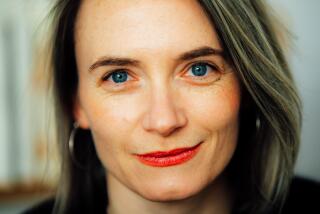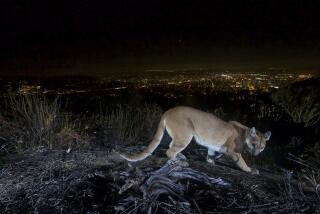‘Crow Planet: Essential Wisdom from the Urban Wilderness’ by Lyanda Lynn Haupt
Crow Planet
Essential Wisdom From
the Urban Wilderness
Lyanda Lynn Haupt
Little, Brown: 230 pp., $23.99
Almost everyone has a crow outside his or her window. Conservative estimates suggest that the crow population in the United States is 31 million -- that’s one for every 10 Americans. In their dark familiarity, crows often breed contempt, infusing our poetry and folklore, paving our streets in guano, amusing and frightening us. But for all that, they are rarely seen for what they are.
In “Crow Planet: Essential Wisdom From the Urban Wilderness,” Lyanda Lynn Haupt frames crows as a mirror reflecting both the natural and the human world. An ornithologist and nature writer -- she’s the author of “Pilgrim on the Great Bird Continent” and “Rare Encounters With Ordinary Birds” and has run educational programs for the Seattle Audubon Society -- Haupt would seem the ideal writer for such a project, but the truth is that she didn’t want to write the book. So what happened? It was the crows.
Haupt was in despair. A self-confessed “post-hippie, Earth-firster, tree-sitting, ecofeminist, radical birdwatcher, Earth Mother,” she had begun to suffer, in Seattle, “a kind of anxious depression, one I attributed . . . to living in the city against the pull of my heart.” Haupt took to her bed and might have stayed there had it not been for a crow’s insistent cawing. She felt compelled to take a look.
Haupt named the crow Charlotte and followed her into the field, which, of course, was Haupt’s own backyard, urban Seattle. Citing geographer Jennifer Wolch, Haupt calls such a landscape the zoöpolis, “the place where the polis meets the zoo, an overlap of human and animal geographies.”
Haupt begins “Crow Planet” by questioning her long-held belief that true nature is outside the human realm. “What exactly did I mean by true nature?” she considers. “And was this not a snobbish attitude? Am I really so much better than the place where I live? I, who am as much an introduced race as any Norway rat?”
Newly attuned to the zoöpolis, Haupt lists birds she sees on a walk between her house and her local Target. She is, she realizes, “somehow allowing these birds to count less in my life, not quite meeting the criteria for a wonder of nature, even from my impoverished vantage of a city sidewalk. But of course they do count. Here, on the road to Target, these birds are as insistent as any secretive forest thrush upon their own wild necessity.”
Crows are no less wild. Fearing that bats have been driven from her neighborhood, Haupt awakes one morning to spot a crow on a utility pole with a bat in its beak. “I was reminded afresh,” she notes, “of one of the crow’s most contradictory purposes in my biological education: in their bold visibility, crows show me what I don’t see.”
It is this visibility, combined with their intelligent behavior, that makes crows so compelling. “Everybody has a crow story,” Haupt states. Crows have been observed playing, working with tools and mourning their dead. They communicate with each other and directly to us.
“Unlike the crow in the ornithological journal,” Haupt observes, “the crow outside our window indulges in a shocking array of behaviors that could only be called anecdotal: they happened, we saw them, and we made them real in telling the tale.” With her sensitivity, careful eye and gift for language, Haupt tells her tale beautifully, using crow study to get at a range of ever-deepening concerns about nature and our place within it, immersing us in a heady hybrid of science, history, how-to and memoir.
It all works because “Crow Planet” is less about procedure than narrative. “[T]he more I watch them,” Haupt writes, “the more their stories speak two messages: the seen and the unseen. . . . The crow’s vivid scrawl does more than inform me about crows; it reminds me of the other wild creatures that ceaselessly encircle me, writing stories of their own unseen lives.”
This sensitivity to interconnectedness graces “Crow Planet.” Haupt’s investigation frequently hops into startling flight, alighting on topics such crow biology and the mechanics of flight, the practice of observation and the composition of concrete and how it symbolizes the fiercely aggregated world in which we live.
Yet “Crow Planet” is no flight of fancy. When confronted with grim climate change predictions in her morning paper, Haupt laments that “[i]t is all just too overwhelming. I try to imagine what hope would look like in such a scenario, hope that bears any semblance of intelligence. There isn’t any, I decide. There is no sensible hope.”
The author knows she must find hope if she is going to stay out of bed. In the end, she finds it in the simple act of communing with nature as we find it, in the process urging us to forge a deeper connection with the contradictions and beauty of the zoöpolis.
Crows, Haupt declares, “press us to our own wilder edges.” Living among us -- but not of us -- they illustrate the limits of our attempts to tame nature while also suggesting that “we can learn another kind of attention that is deeper, wilder, more creative, more native, more difficult, and far more beautiful than that which has come to be accepted as adequate.”
Schickel is the author of “You’re Not the Boss of Me: Adventures of a Modern Mom.”
More to Read
The biggest entertainment stories
Get our big stories about Hollywood, film, television, music, arts, culture and more right in your inbox as soon as they publish.
You may occasionally receive promotional content from the Los Angeles Times.










